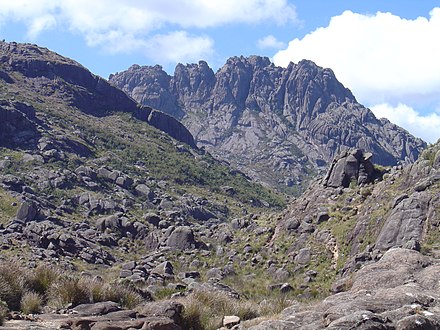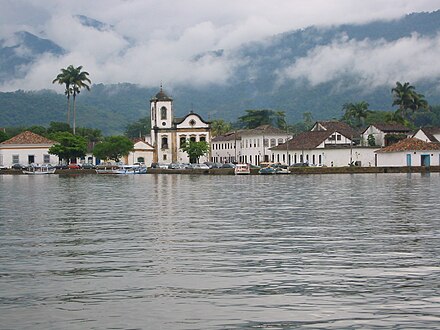Southeast (Brazil) - region of Brazil
 Southeast Brazil is the cultural and economic hub of the country, and contains three of the four largest cities: São Paulo, Rio de Janeiro, and Belo Horizonte. It is the richest region of the country and it leads the country in population, urban population, population density, industries, universities, airports, ports, highways, hospitals, schools, houses and many other areas. It also has a lot to see outside of the cities, with national parks such as Itatiaia and Serra da Canastra and a long and beautiful coastline with popular destinations like Paraty, Caraguatatuba, and Guarapari.
Southeast Brazil is the cultural and economic hub of the country, and contains three of the four largest cities: São Paulo, Rio de Janeiro, and Belo Horizonte. It is the richest region of the country and it leads the country in population, urban population, population density, industries, universities, airports, ports, highways, hospitals, schools, houses and many other areas. It also has a lot to see outside of the cities, with national parks such as Itatiaia and Serra da Canastra and a long and beautiful coastline with popular destinations like Paraty, Caraguatatuba, and Guarapari.
States

Cities
- Belo Horizonte - Third largest city in the country, and capital of Minas Gerais.
- Niterói - The city across the Guanabara Bay from Rio de Janeiro. There are beautiful beaches and mountains you can go to the top of them and view all the beauty of Rio. A visit to Itacoatiara beach is recommended.
- Ouro Preto - Most beautiful colonial town in Brazil, has a large collection of Baroque art of the 16th and 17th centuries, the golden age in the country. Monumental churches, museums and urban tracks are now protected as World Heritage Site by UNESCO.
- Paraty - Quaint coastal colonial town with cobblestone streets, hiking options, and access to hundreds of small islands in the Bay of Ilha Grande
- Rio de Janeiro - Brazil's "marvelous city", with famous beaches such as Copacabana and Ipanema
- São Paulo - Largest city in South America, a sprawling metropolis with a vast array of cultural, culinary, and shopping options.
- Santos - An important port city in São Paulo state, home of the football club for which Pelé played most of his career.
- Tiradentes - A well preserved historic town in the state of Minas Gerais.
- Vitória - The capital of the state of Espírito Santo. It is famous for its beautiful bay, the alongside Convento da Penha (a hilltop Franciscan convent dating from the 16th century), its beaches and nightlife.
Other destinations
- Caraça
- Ilha Grande
- Itatiaia National Park
- Pedra Azul State Park — the main attraction of this 12 square meters park is its 1909 meters high peak, Pedra Azul, which got its name due to the blue tonality reflected on the rock at some moments of the day
- Serra da Canastra National Park
- Serra da Mantiqueira
- Serra da Bocaina National Park
Understand
Since the 18th century, Brazil’s Southeast has been the heart of the country’s economy. Firstly, with the intense gold and diamond mining in the state of Minas Gerais, which gave birth to several colonial towns - many of them still well-preserved, as well as the transfer of the country’s capital from Salvador to Rio de Janeiro in 1763. When the mining activities declined, the coffee produced in the region took its place as the country’s main export, followed by Brazil’s industrialization, which helped develop the region from the 1930s on. Today, the Southeast is still the most populous and economically powerful of the country’s regions, besides being the epicenter of the Brazil’s cultural industries. Nevertheless, it is still to overcome problems that plague the rest of the country, such as the extreme contrast between the rich and the poor, and the lack of security in the metropolises. In spite of that, São Paulo and Rio are the main gateways to Brazil, both for business and leisure travelers, and the region offers countless attractions to all its visitors.
Climate
The diverse landscapes of the southeast can have very different climates altogether – check the state articles for details. As a general rule, areas along the coastline can be hot and humid year-round – less so in winter. Northern Minas Gerais is also hot, but drier. In higher altitude areas (such as São Paulo (city), southern Minas Gerais and the mountains of Rio state) winters are usually cool. Summer is the wettest season whereas winters are generally drier.
Talk
English is normally spoken only at the tourism businesses (hotels and a few more tourist-oriented restaurants), and by the well-educated upper classes. Do not assume everyone speaks Spanish. Brazilians do not like to be mistaken for Spanish-speakers and some can find it rude to be approached in Spanish. Portuguese is spoken with variations in accent and a few tweaks in vocabulary. Some of them may be interesting for the traveller to know:
- Semáforo (traffic lights): Sinal (in Minas and Rio), farol (in São Paulo)
Get in
By plane
São Paulo has the country's largest number of international links. Note that some connections to domestic flights may require a change between airports, from Guarulhos International (IATA: GRU) to Congonhas (IATA: CGH), which is a busy national hub.
Rio de Janeiro (IATA: GIG) also receives international flights, including the only direct flight to Angola. Rio's other airport (IATA: SDU) serves only domestic destinations.
Other cities with international connections are Belo Horizonte (from Portugal) and Cabo Frio, in the Buzios region, with flights to and from Buenos Aires.
Get around
See
- Colonial heritage is preserved in many small towns such as Paraty, Ouro Preto, Tiradentes, and Diamantina. Old churches in Brazilian baroque style, courthouses, manors, and town halls recall the stories of early immigration, the Inconfidência Mineira against the Portuguese crown, and the gold and diamond rushes for which Minas Gerais is named.
Do
- Bonete Jungle Trail (Trilha do Bonete) – A beautiful 2-day jungle trail on Ilhabela island with picturesque waterfalls, refreshing river pools, beautiful beaches, and flora and fauna of the Atlantic rain forest.
- Estrada Real – Cutting through the States of Minas Gerais and São Paulo to the port cities of Paraty and Rio de Janeiro, the Royal Road is one of the oldest roads in the Americas. It thrived during the diamond and gold-digging ages, linking many of the most important historic towns in the region.
Eat
Drink
One may enjoy a delicious caipirinha. This drink is Brazil's national cocktail, made with cachaça (pronounced [kaˈʃasɐ]), sugar and lemon. Cachaça is Brazil's most common distilled alcoholic beverage. While both rum and cachaça are made from sugarcane-derived products, most rum is made from molasses. Specifically with cachaça, the alcohol results from the fermentation of sugarcane juice that is afterwards distilled.

